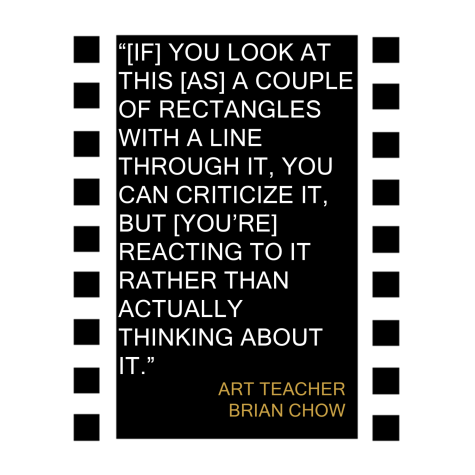Is it even art?
Examining how community members define art in the modern world
February 8, 2023
“Art is difficult to define and quantify through empirical means, but we can experience it on the deepest levels across any differences or similarities we might have as human beings,” art teacher Brian Chow said. “Modern art is focused on not having boundaries…It’s [really] about the total body or total sensory experience.”
According to Chow, modern art’s increasingly flexible definition leads to a more immersive experience for viewers regardless of the medium. He believes this lack of boundaries allows more people to partake in the creation of art.
An artist, senior Stephanie Zhao likes to paint and draw to express herself. Zhao agrees with Chow, as she feels the loose definition of modern art allows for a more diverse expression of creativity while alleviating some of the potential fear people may have surrounding self identifying as artists. However, Zhao also believes the increased accessibility of artistry can lead to a decline in the quality of art, referencing art made by swirling dripping paint buckets over a canvas as an example, because she says “there’s no real creativity involved.”
“When I make my art, I like to think about why I’m doing it,” Zhao said. “Like, what am I trying to express with it? When you’re just pouring paint on a canvas, what exactly can you express? I don’t know.”

Zhao feels that to some degree, modern art is done “more to appeal to the masses and consumerism than for creative expression,” and, as a result, is often created without intent. Chow agrees, saying that creating art with intention is important, but viewers’ interpretations of the art cannot be discounted either. Chow believes that being forceful with creating work with a message leads to the expression of a high value piece, which is not something that can be obtained as easily with “word vomit.”
“Being an artist is a mindset,” Chow said. “Just because you can make a basket in basketball and have a high percentage doesn’t mean you’re a good basketball player. It just means you’re good at shooting baskets — one particular thing. [It’s the same] when it comes to art — there’s more to it than being good at one skill.”
Freshman Courtney Masli feels that there has been a shift in the resources needed to create and make a living off of art as a result of social media, which makes it easier for people to show their creations to a large audience. Chow agrees, referencing alum Zach Hsieh, who has 25 million subscribers on his YouTube channel, ZHC, as an example of someone who has been able to make a living off of art as a result of social media.
According to Chow, minimalist modern art paintings often draw criticism from onlookers because of how much they cost. In reference to the painting “Black Fire” by Barnett Newman — a pioneer artist of the impressionist movement — which was sold for 84.2 million dollars in an auction, Chow feels that people who simply view the painting and ridicule the price are misguided and are not fully taking into consideration the intention behind the piece and its context.
“You’re not talking about how many billable hours [it took] to make the [art],” Chow said. “You dismiss the 30 years of work this person created. You dismiss their fame or notoriety for how they [pioneered] to push the art in their respective area [because] you’re like, ‘Oh, I could have done that.’ But you didn’t do it. If you look at this [as] a couple of rectangles with a line through it, you can criticize it, but [you’re] reacting to it rather than actually thinking about it.”

Masli feels the value of art is subjective, and the amount of money an individual is willing to pay for a piece of art should not matter to other people. Though she prefers art that has intricacy, citing Gustav Klimt’s 1907 painting “The Lady in Gold” as an example, she doesn’t discount the value of simpler pieces, saying other people may find more value in them.
The price of modern art pieces has struck much global discussion, and Chow agrees with Masli on the complications judging modern art in relation to its price. Chow references street artist Banksy’s “Girl with a Balloon” painting, which self-destructed after it was sold for 1.4 million dollars at an auction. Banksy added a shredder inside his painting frame that began operating just after the painting was sold, and according to Chow, produced a commentary on what is valued and is not valued in art by making a farce out of his own work. Chow feels that street artists like Banksy, who often produce illegal street art, represent an essential aspect of modern art — bringing attention to proceedings that others try to cover up.
“[They] point out the underbelly of our society that we don’t want to look at,” Chow said. “That’s what street artists do, what modern artists do. [People say] ‘I don’t want to look at that. Let’s just pave over it, get some gardeners to clean it up.’ We’re lucky that way, but it still exists. [And part of] the importance of modern art is bringing [attention] to it.”



















